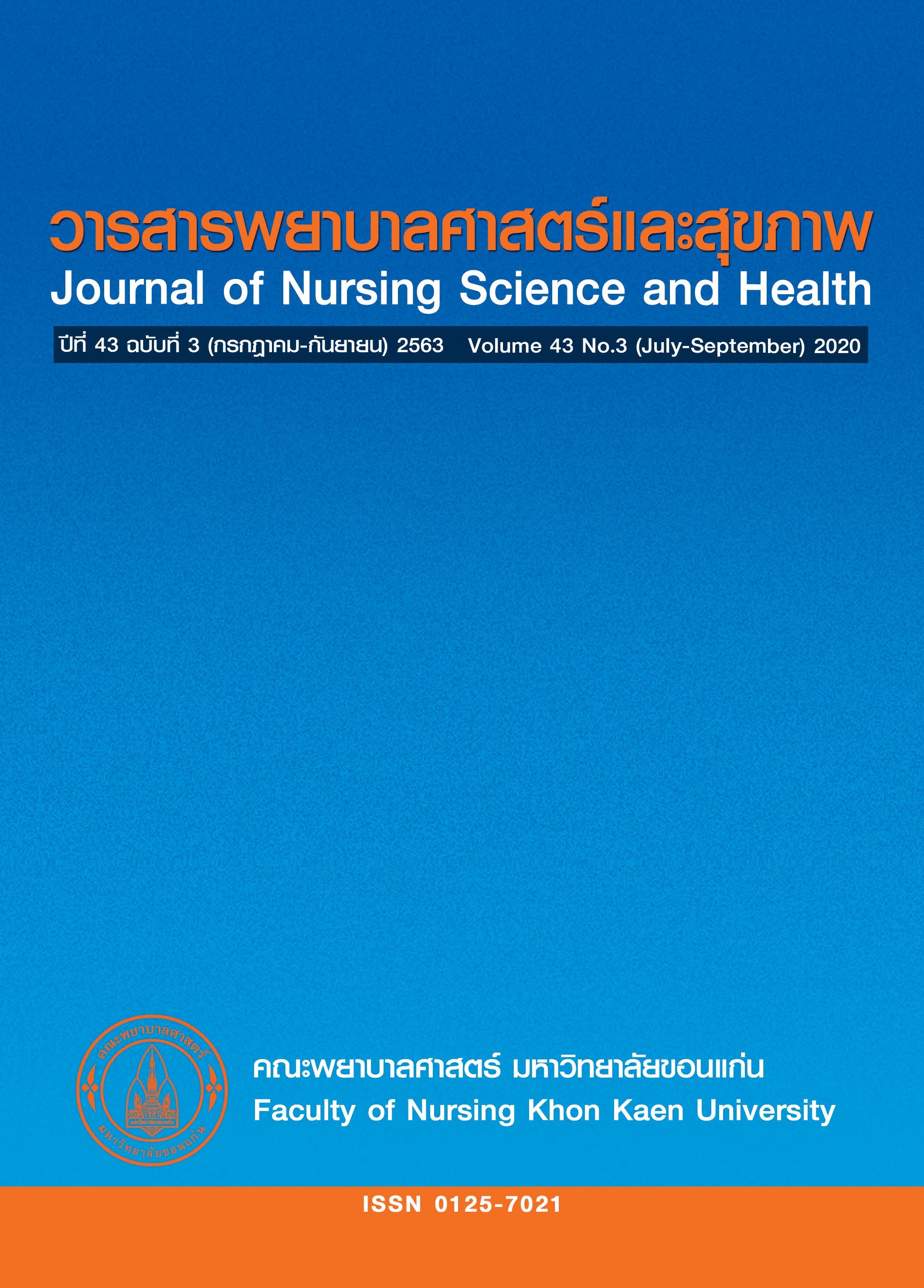Prevalence and risk factors for needlestick injuries among nursing students in Henan Province, China
Keywords:
needlestick injuries; occupational hazard; nursing studentAbstract
The cross-sectional study was conducted to assess the prevalence and factor associated with needlestick injuries (NSIs) among nursing students in Henan Province, China. Simple random was used to recruited 400 nursing students. Data were collected through structured questionnaire. Descriptive statistics and multiple logistic regression were applied to analyze data. Results of study showed that prevalence among nursing students was 67%. Factors associated with needlestick injuries were female (aOR=2.9,95% CI=1.1–7.9), knowledge of NSIs prevention (aOR= 2.8, 95% CI =1.6–4.8) and low attitude toward NSIs prevention (aOR= 9.0, 95% CI =3.5–23.3). Chinese Nursing Association are able to use the results of this study to improve regulation of NSIs prevention and guideline for nursing students.
References
Sriram S. Study of needle stick injuries among healthcare providers: Evidence from a teaching hospital in India. J Fam Med Prim Care 2019;8(2):599–603. doi:10.4103/jfmpc.jfmpc_454_18
Auta A, Adewuyi EO, Tor-Anyiin A, et al. Global prevalence of percutaneous injuries among healthcare workers: A systematic review and meta-analysis. Int J Epidemiol 2018;47(6): 1972–80. doi:10.1093/ije/dyy208
Gupta D, Saxena S, Agrawal VK, et al. Study of knowledge, attitude and practice of needle stick injury among nurses in a tertiary care hospital. Int J Community Med Public Heal 2019; 6(2):865. doi:10.18203/2394-6040.ijcmph20190221
Zhang X, Chen Y, Li Y, et al. Needlestick and sharps injuries among nursing students in Nan-jing, China. Workplace Health Saf 2018;66(6):276–84. doi:10.1177/2165079917732799
Bao J, Wang F, Hu C. Investigation of needlestick injuries among nursing students in the gen-eral hospital. J Nurs Adm 2015;15(2):135-36.
Isara AR, Oguzie KE, Okpogoro OE. Prevalence of needlestick injuries among healthcare workers in the accident and emergency department of a teaching hospital in Nigeria. Ann Med Health Sci Res 2015;5(6):392–6. doi:10.4103/2141-9248.177973
Cooke CE, Stephens JM. Clinical, economic, and humanistic burden of needlestick injuries in healthcare workers. Med Devices (Auckl) 2017;10:225–35. doi:10.2147/MDER.S140846
Black Thomas LM. Nursing faculty experiences with students' needlestick injuries [published online ahead of print, 2020 Feb 20]. Nurse Educ. 2020;10.1097/NNE.0000000000000810. doi:10.1097/NNE.0000000000000810
Yao WX, Yang B, Yao C, et al. Needlestick injuries among nursing students in China. Nurse Educ Today 2010;30(5):435–7. doi:10.1016/j.nedt.2009.09.018
Zhao F, Zhang M, Xuan J, et al. A large-scale cross-sectional survey on needle-stick injuries related to injections of antidiabetics in China: incidence and infection rates. Value Heal. 2018; 21(1):S72. doi:10.1016/j.jval.2018.04.479
Suliman M, Al Qadire M, Alazzam M, et al. Students nurses' knowledge and prevalence of needle stick injury in Jordan. Nurse Educ Today 2018;60:23–7. doi:10.1016/j.nedt.2017.09.015
Lukianskyte R, Gataeva J, Radziunaite L. Needle sticks and sharps injuries experienced by staff nurses and nursing students and their prevention. Int J Infect Control 2012;8(1):3–9. doi:10.3396/ijic.v8i1.002.12.
Guo YH, Lyu YY, Yang JH, et al. Data analysis on hepatitis B through pilot surveillance re-porting system in Henan Province, 2012-2016. Zhonghua Liu Xing Bing Xue Za Zhi 2018; 39(4):500–04. doi:10.3760/cma.j.issn.0254-6450.2018.04.023
World Health Organization. Joint WHO/ILO policy guidelines on improving health worker ac-cess to prevention, treatment and care services for HIV and TB. Geneva; 2010.
American Nurses Association. Workplace safety and needlestick injuries are top concerns for nurses. Silver Spring; 2008
Tirpude AP, Gaikwad M, Tirpude PA et al. Retrospective analysis of prevalent anatomy spot-ter's examination: an educational audit. Korean J Med Educ. 2019;31(2):115–24. doi:10.3946/kjme.2019.123
Setthamas M, Sawaengdee K, Theerawit T, et al. Incidence and risk factors of needle stick and sharp injuries among registered nurses in Thailand. J Public Heal Dev 2018;16(1):17–28.
Ghanei Gheshlagh R, Aslani M, Shabani F, et al. Prevalence of needlestick and sharps injuries in the healthcare workers of Iranian hospitals: an updated meta-analysis. Environ Health Prev Med 2018; 23(1): 44. doi:10.1186/s12199-018-0734-z
Zhang MX, Yu Y. A study of the psychological impact of sharps injuries on health care workers in China. Am J Infect Control 2013;41(2):186–7. doi: 10.1016/j.ajic.2012.02.023
Motaarefi H, Mahmoudi H, Mohammadi E, et al. Factors associated with needlestick injuries in health care occupations: A systematic review. J Clin Diagnostic Res 2016;10(8):IE01–04. doi: 10.7860/JCDR/2016/17973.8221
Wang C, Whitehead L, Bayes S. Nursing education in China: Meeting the global demand for quality healthcare. Int J Nurs Sci 2016;3(1):131–6. doi: 10.1016/j.ijnss.2016.02.009
Pavithran VK, Murali R, Krishna M, et al. Knowledge, attitude, and practice of needle stick and sharps injuries among dental professionals of Bangalore, India. J Int Soc Prev Community Dent 2015;5(5):406–12. doi:10.4103/2231-0762.165932
Madhavan A, Asokan A, Vasudevan A, et al. Comparison of knowledge, attitude, and practices regarding needle-stick injury among health care providers. J Fam Med Prim Care 2019;8(3): 840–5. doi:10.4103/jfmpc.jfmpc_103_19
Garus-Pakowska A, Górajski M. Behaviors and attitudes of Polish health care workers with respect to the hazards from blood-borne pathogens: a questionnaire-based study. Int J Environ Res Public Health 2019;16(5):891. doi:10.3390/ijerph16050891
Gogoi J, Ahmed SJ, Saikia H, et al. A study on knowledge, attitude, practice and prevalence of needle stick injuries among health care workers in a tertiary care hospital of Assam. Int J Community Med Public Health 2017;4:2031–5. doi:10.18203/2394-6040.ijcmph20172171
Downloads
Published
How to Cite
Issue
Section
License
The Journal of Nursing Science and Health is copyright holder of published articles. Distributions of articles published in Journal of Nursing Science and Health including online, photocopying which is not for teaching-learning purpose, publication submission elsewhere are prohibited except obtaining permission from the Journal of Nursing Science and Health.



